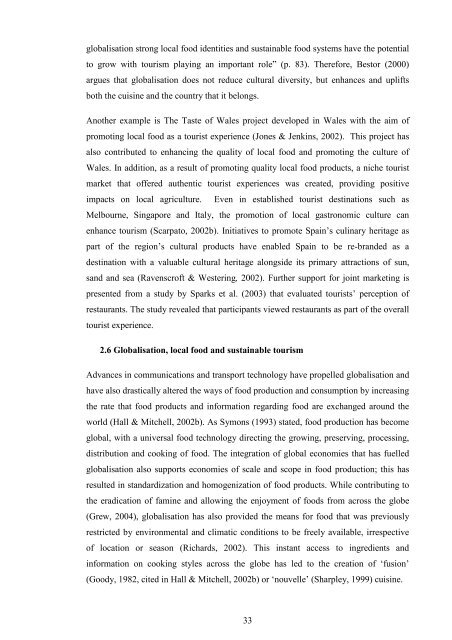The Role of Local Food in Maldives Tourism - Scholarly Commons ...
The Role of Local Food in Maldives Tourism - Scholarly Commons ...
The Role of Local Food in Maldives Tourism - Scholarly Commons ...
You also want an ePaper? Increase the reach of your titles
YUMPU automatically turns print PDFs into web optimized ePapers that Google loves.
globalisation strong local food identities and susta<strong>in</strong>able food systems have the potential<br />
to grow with tourism play<strong>in</strong>g an important role” (p. 83). <strong>The</strong>refore, Bestor (2000)<br />
argues that globalisation does not reduce cultural diversity, but enhances and uplifts<br />
both the cuis<strong>in</strong>e and the country that it belongs.<br />
Another example is <strong>The</strong> Taste <strong>of</strong> Wales project developed <strong>in</strong> Wales with the aim <strong>of</strong><br />
promot<strong>in</strong>g local food as a tourist experience (Jones & Jenk<strong>in</strong>s, 2002). This project has<br />
also contributed to enhanc<strong>in</strong>g the quality <strong>of</strong> local food and promot<strong>in</strong>g the culture <strong>of</strong><br />
Wales. In addition, as a result <strong>of</strong> promot<strong>in</strong>g quality local food products, a niche tourist<br />
market that <strong>of</strong>fered authentic tourist experiences was created, provid<strong>in</strong>g positive<br />
impacts on local agriculture. Even <strong>in</strong> established tourist dest<strong>in</strong>ations such as<br />
Melbourne, S<strong>in</strong>gapore and Italy, the promotion <strong>of</strong> local gastronomic culture can<br />
enhance tourism (Scarpato, 2002b). Initiatives to promote Spa<strong>in</strong>’s cul<strong>in</strong>ary heritage as<br />
part <strong>of</strong> the region’s cultural products have enabled Spa<strong>in</strong> to be re-branded as a<br />
dest<strong>in</strong>ation with a valuable cultural heritage alongside its primary attractions <strong>of</strong> sun,<br />
sand and sea (Ravenscr<strong>of</strong>t & Wester<strong>in</strong>g, 2002). Further support for jo<strong>in</strong>t market<strong>in</strong>g is<br />
presented from a study by Sparks et al. (2003) that evaluated tourists’ perception <strong>of</strong><br />
restaurants. <strong>The</strong> study revealed that participants viewed restaurants as part <strong>of</strong> the overall<br />
tourist experience.<br />
2.6 Globalisation, local food and susta<strong>in</strong>able tourism<br />
Advances <strong>in</strong> communications and transport technology have propelled globalisation and<br />
have also drastically altered the ways <strong>of</strong> food production and consumption by <strong>in</strong>creas<strong>in</strong>g<br />
the rate that food products and <strong>in</strong>formation regard<strong>in</strong>g food are exchanged around the<br />
world (Hall & Mitchell, 2002b). As Symons (1993) stated, food production has become<br />
global, with a universal food technology direct<strong>in</strong>g the grow<strong>in</strong>g, preserv<strong>in</strong>g, process<strong>in</strong>g,<br />
distribution and cook<strong>in</strong>g <strong>of</strong> food. <strong>The</strong> <strong>in</strong>tegration <strong>of</strong> global economies that has fuelled<br />
globalisation also supports economies <strong>of</strong> scale and scope <strong>in</strong> food production; this has<br />
resulted <strong>in</strong> standardization and homogenization <strong>of</strong> food products. While contribut<strong>in</strong>g to<br />
the eradication <strong>of</strong> fam<strong>in</strong>e and allow<strong>in</strong>g the enjoyment <strong>of</strong> foods from across the globe<br />
(Grew, 2004), globalisation has also provided the means for food that was previously<br />
restricted by environmental and climatic conditions to be freely available, irrespective<br />
<strong>of</strong> location or season (Richards, 2002). This <strong>in</strong>stant access to <strong>in</strong>gredients and<br />
<strong>in</strong>formation on cook<strong>in</strong>g styles across the globe has led to the creation <strong>of</strong> ‘fusion’<br />
(Goody, 1982, cited <strong>in</strong> Hall & Mitchell, 2002b) or ‘nouvelle’ (Sharpley, 1999) cuis<strong>in</strong>e.<br />
33

















